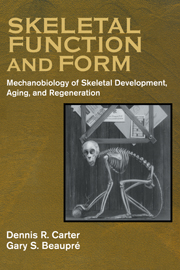Book contents
- Frontmatter
- Contents
- Preface
- Chapter 1 Form and Function
- Chapter 2 Skeletal Tissue Histomorphology and Mechanics
- Chapter 3 Cartilage Differentiation and Growth
- Chapter 4 Perichondral and Periosteal Ossification
- Chapter 5 Endochondral Growth and Ossification
- Chapter 6 Cancellous Bone
- Chapter 7 Skeletal Tissue Regeneration
- Chapter 8 Articular Cartilage Development and Destruction
- Chapter 9 Mechanobiology in Skeletal Evolution
- Chapter 10 The Physical Nature of Living Things
- Appendix A Material Characteristics
- Appendix B Structural Characteristics
- Appendix C Failure Characteristics
- Index
Preface
Published online by Cambridge University Press: 11 January 2010
- Frontmatter
- Contents
- Preface
- Chapter 1 Form and Function
- Chapter 2 Skeletal Tissue Histomorphology and Mechanics
- Chapter 3 Cartilage Differentiation and Growth
- Chapter 4 Perichondral and Periosteal Ossification
- Chapter 5 Endochondral Growth and Ossification
- Chapter 6 Cancellous Bone
- Chapter 7 Skeletal Tissue Regeneration
- Chapter 8 Articular Cartilage Development and Destruction
- Chapter 9 Mechanobiology in Skeletal Evolution
- Chapter 10 The Physical Nature of Living Things
- Appendix A Material Characteristics
- Appendix B Structural Characteristics
- Appendix C Failure Characteristics
- Index
Summary
This book is about how function determines form. Our objective is to present a consistent approach for understanding the role of mechanical factors in skeletal development, growth, maintenance, functional adaptation, and aging. A conceptual framework for understanding how mechanically mediated events may influence the evolution of the vertebrate skeleton is also provided. The text is a synopsis of the scientific perspective that has been developed by our research group at Stanford University and the VA Palo Alto Health Care System. Our intention is to provide a single source in which these ideas are summarized for anatomists, anthropologists, bioengineers, biologists, biophysicists, molecular geneticists, paleontologists, physicians, surgeons, and students in the physical and life sciences.
A phylogenetic framework is introduced in which chronological stages of skeletal ontogeny are followed in successive chapters. The first chapter provides a historical background on the study of musculoskeletal form and function, touching on developmental and evolutionary questions. The second chapter presents basic information on the histomorphology of skeletal tissues and a brief introduction to mechanical principles that are used throughout the book. Chapters 3 through 8 then follow human skeletal ontogeny from the initial formation of joints and bone in the embryo through the destruction of articular cartilage in the aged. Chapter 9 then returns to the phylogenetic level to consider the implications of developmental mechanics for the skeletal features in extinct and extant taxa. Chapter 10 offers some closing thoughts on the physical nature of living things.
We aspire to bridge important gaps between disciplines in a manner that will provide common ground for understanding and future investigation.
Information
- Type
- Chapter
- Information
- Skeletal Function and FormMechanobiology of Skeletal Development, Aging, and Regeneration, pp. xi - xiiPublisher: Cambridge University PressPrint publication year: 2000
